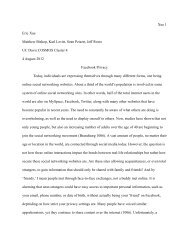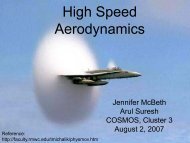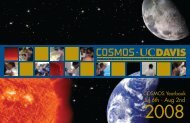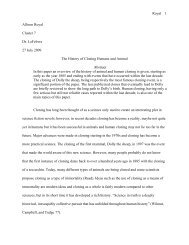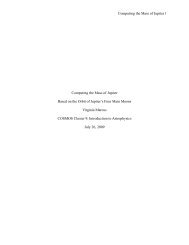Ding, Anthony - COSMOS - UC Davis
Ding, Anthony - COSMOS - UC Davis
Ding, Anthony - COSMOS - UC Davis
You also want an ePaper? Increase the reach of your titles
YUMPU automatically turns print PDFs into web optimized ePapers that Google loves.
H-R diagram of M29 8<br />
Conclusion<br />
Although it is a little bit off, the H-R diagram of M29 represents the typical H-R<br />
diagram of a cluster of stars. The line of data points stretching from the bottom left to the<br />
middle is what is known as the main sequence, where most of the stars are. The almost<br />
vertical line branching out of the main sequence is known as the Red Giant branch. With<br />
knowledge about these two branches, it is possible to estimate the age of M29. In order to<br />
do this, it is necessary to locate a star just about to leave the main sequence and just about<br />
to enter the Red Giant branch. In other words, we need to find the “turning point”. Once<br />
we find the star, we need to convert that star’s B-V value into its temperature, and then<br />
into its spectral type. Knowing its spectral type, we can then match the star up with a<br />
table that compares a star’s spectral type to its average lifetime in the main sequence.<br />
This estimated age is correct because the lifetime given is the lifetime in the main<br />
sequence, and the star chosen is one just about to leave the main sequence. And since all<br />
stars are born at the same time in a star cluster, we can say that the age of the star is<br />
roughly equal to the age of the cluster. In the case of M29, the turn-off point is within an<br />
approximate range of -0.09 to 0.1. Using a chart that matches temperature B-V values to<br />
temperature (Sloan Digital Sky Survey n.d.), we know that this corresponds to a<br />
temperature range of about 11,000K to 9,000K. Using another chart, we know that the<br />
particular stars in the turning point range are spectral type B stars (Nave 2009). This tells<br />
us that the star, and thus the cluster, is around 10 million to 100 million years old (Wilcox<br />
2005). The actual estimated age of M29, using much more accurate data, is 10 milion<br />
years old (Frommert and Kronberg 2007). The large range of 10 million to 100 million<br />
calculated with the data from this paper is due to the fact that open clusters are spread out,




